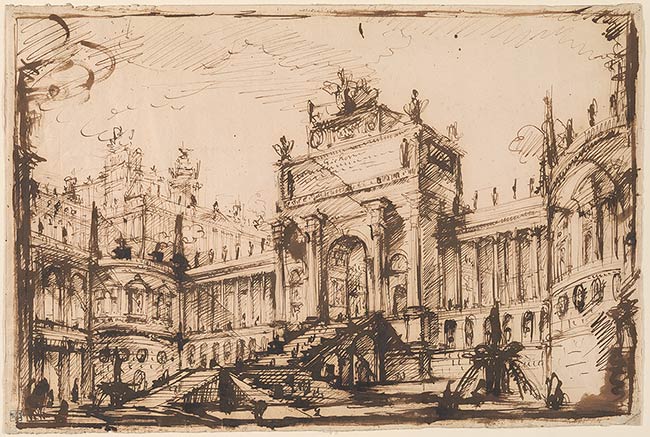
Although Piranesi is best known today for his architectural fantasies--especially for his splendid etchings of Imaginary Prisons, the Carceri--such works really only occupied the first twenty years of his career, after which he concentrated more on the archaeological interpretation of ancient Rome and on views of the modern city. Among his surviving drawings, that is, there are more than 120 architectural fantasies, but only twenty or so can be dated after 1760. This sheet, dating to around 1765, is representative of that late group of fantasies, which demonstrate both Piranesi's utter mastery of architectural draftsmanship as well as his greater understanding of ancient Roman buildings, even though in such a fantasy, he played with conventional forms of ancient Roman architecture by combining them in new, unconventional ways. Here, a triumphal arch is approached by a monumental stair and surrounded by a colonnade, an arrangement with no real ancient precedent, and the curving corners of the courtyard seem more likely inspired by the Baroque architecture of Francesco Borromini than by any ancient source. The drawn border is a rarity in Piranesi's work and suggests that this sheet was an end in itself, an autonomous drawing never meant to be translated into print. There may also have been a kind of bravura performance in creating works of this type, drawn directly with the darkest ink, without the benefit of any preliminary sketching in chalk. Indeed, a related drawing, the Fantasy of a Magnificent Triumphal Art at the National Gallery of Art in Washington (inv. 1986.32.1) is the only signed and dated drawing in all Piranesi's known work, and it is inscribed on the verso “Drawn at Rome in the presence of Joseph Wyndham Esq.” We can imagine the astonished thrill that young English antiquarian must have felt in watching such a fantasy appear on the page; that is was drawn before Wyndham's eyes suggests that it was thrown off with as much haste as the jagged crosshatching suggests. The Morgan's Fantasy of a Magnificent Forum is a similarly pure drawing, the outpouring of a mind filled with grand architectural visions, the very epitome of Piranesi's “sublime ideas.”
Watermark: letter "P"
Scholz, János, former owner.
Stampfle, Felice, and Jacob Bean. Drawings from New York collections. III: The eighteenth century in Italy. New York : Metropolitan Museum of Art : Pierpont Morgan Library, 1971, no. 226, repr.
Ryskamp, Charles, ed. Seventeenth Report to the Fellows of the Pierpont Morgan Library, 1972-1974. New York : Pierpont Morgan Library, 1976, p. 176.
Scholz, János. Italian Master Drawings, 1350-1800, from the János Scholz Collection. New York : Dover, 1976, no. 144, repr.
Denison, Cara, Myra Nan Rosenfeld, and Stephanie Wiles. Exploring Rome : Piranesi and His Contemporaries. New York : Pierpont Morgan Library; Montréal : Centre Canadien d'Architecture, 1993, no. 25, repr.
From Leonardo to Pollock: Master drawings from the Morgan Library. New York: Morgan Library, 2006, cat. no. 26, p. 58-59.
Marciari, John. Sublime Ideas: Drawings by Giovanni Battista Piranesi. New York: Morgan Library, 89-91.
